
Chrysoberyl Gemstone: Nneɛma, Nkyerɛase, Botae & Nea Ɛkeka Ho
 Chrysoberyl aboɔden abo yɛ ahwehwɛ a ɛyɛ den na ɛyɛ mmerɛw a ɛwɔ kɔla ahorow, nanso mpɛn pii no ɛyɛ ɛwo-sika kɔkɔɔ kosi ahabammono a ɛyɛ mmerɛw. Sɛnea wɔbɔ chrysoberyl din yiye ne kri -suh-beh-ruhl.
Chrysoberyl aboɔden abo yɛ ahwehwɛ a ɛyɛ den na ɛyɛ mmerɛw a ɛwɔ kɔla ahorow, nanso mpɛn pii no ɛyɛ ɛwo-sika kɔkɔɔ kosi ahabammono a ɛyɛ mmerɛw. Sɛnea wɔbɔ chrysoberyl din yiye ne kri -suh-beh-ruhl.
So chrysoberyl yɛ ɔbo a ɛsom bo ? Dabi, nanso chrysoberyl yɛ den sen emerald , aboɔden abo a ɛsom bo a ɛwɔ beryl abusua no mu. Sɛ yɛreka ho asɛm a, momma yɛnma hann bi mma chrysoberyl vs. beryl.
Wɔn din di nsɛ, nanso ɛsono chrysoberyl ne beryl. Wɔn baanu nyinaa wɔ beryllium ne aluminium, nanso beryl yɛ silicate, bere a chrysoberyl yɛ oxide.
Sɛ yɛka ne nyinaa bom a, wonim chrysoberyl sɛ ɛyɛ kɔkɔɔ a ɛyɛ mmerɛw na etumi sesa kɔla anaasɛ ɛda “ ɔkraman aniwa ” adi wɔ ahorow bi mu.
Wɔ akwankyerɛ yi mu no, wobɛsua deɛ ɛma chrysoberyl ahodoɔ biara yɛ soronko na ɛsom boɔ, ne chrysoberyl aboɔden aboɔ su, ayaresa dwumadie, ne nea ɛkeka ho!

Ɛfa Chrysoberyl Ɔbo ho
Ebia wɔde aguadi din afoforo te sɛ “apuei fam chrysolite” anaa “Ceylonese chrysolite,” a ɛyɛ sika kɔkɔɔ-kɔla a efi Ceylon (nnɛyi Sri Lanka) bɛkɔ chrysoberyl. Nanso, mprempren chrysolite kyerɛ peridot nkutoo.
Sɛ wunim chatoyancy, “ɔkraman aniwa” nkɛntɛnso no ho asɛm a, wunim sɛ aboɔden abo pii betumi ada no adi. Nanso ɔkraman aniwa bo bɛn na eye sen biara? Ɛnyɛ den — chrysoberyl!
“Chrysoberyl ɔkraman aniwa” no agye din yiye araa ma, chatoyant chrysoberyl aboɔden abo nkutoo na wobetumi aka sɛ “ɔkraman aniwa aboɔden abo” ara kwa. Sɛ nhwɛso no, worenkyerɛw chatoyant apatite sɛ “ɔkraman aniwa aboɔden abo” — wobɛka sɛ “ɔkraman aniwa apatite.”
Chrysoberyl yɛ nsoromma mu hwɛ bo ma Virgo, na ne kɔla ahorow a ɛsakra alexandrite yɛ June awobo . Alexandrite nso yɛ atetesɛm mu aboɔden abo a wɔde kae ayeforohyia mfe 55 ! Awarefo nkumaa betumi de atetesɛm mu chrysoberyl cat’s eye aboɔden abo nso adi wɔn ayeforohyia mfe 18.

Chrysoberyl Nkyerɛkyerɛmu & Su ahorow
Aluminium, beryllium, ne oxide na ɛyɛ chrysoberyl. Iron yɛ efĩ a ɛtaa ba chrysoberyl a ɛyɛ daa mu, bere a chromium wɔ alexandrite ne cymophane (a yɛbɛka ho asɛm kakra) mu.
Wobɛyɛ dɛn ahu sɛ chrysoberyl yɛ nokware anaa? Adesua a ɛyɛ mmerɛw sen biara ne sɛnea ɛyɛ den.
Chrysoberyl ntumi nsɛe no yiye, na ɛwɔ 8.5 wɔ Mohs mineral hardness scale so . Nokwarem no, chrysoberyl ne abɔde mu aboɔden abo a ɛto so abiɛsa a ɛyɛ den sen biara!
Enti, wubetumi de topaz (8-level hardness) ayɛ scratch sɔhwɛ. Sɛ ɛyɛ ade a ɛyɛ mmerɛw a wɔde besi chrysoberyl ananmu, te sɛ quartz , a, topaz bɛtwetwe.
Hwehwɛ chrysoberyl ahoɔden a aka no wɔ ase ha:
Kɔla : Mpɛn pii no ɛyɛ kɔkɔɔ a ɛyɛ mmerɛw anaa kɔkɔɔ-ahabammono, ɛtɔ mmere bi a ɛyɛ ahabammono, bruu, anaa borɔdɔma (chrysoberyl); Ɛwo-biribiri, sika kɔkɔɔ-kɔla, ahabammono-kɔla, anaa ahabammono (cymophane); Kɔkɔɔ-kɔkɔɔ, pink, anaa ruby-kɔkɔɔ & bruu-ahabammono, bruu, anaa emerald-ahabammono (alexandrite); Mint ahabammono anaa bruu-ahabammono (vanadium) .
Ahwehwɛ nhyehyɛe : Orthorhombic
Luster : Vitreous (te sɛ ahwehwɛ) .
Transparency : Ɛyɛ nea ɛda adi pefee kosi nea ɛda adi pefee
Nneɛma a ɛma hann yɛ hyew : 1.74-1.76
Nnipa dodow : 3.50-3.84
Cleavage : Ɛda nsow wɔ [110] so, ɛnyɛ pɛ wɔ [010] so, ɛnyɛ papa wɔ [001] so.
Fracture : Ɛnyɛ daa/ɛnyɛ pɛpɛɛpɛ anaasɛ ɛyɛ conchoidal
Streak : Ɛyɛ fitaa
Luminescence : Ɛntaa mma sɛ chrysoberyl a ɛyɛ ahabammono: Fluorescence a ɛyɛ mmerɛw wɔ kɔkɔɔ-ahabammono mu wɔ SW-UV ase
Pleochroism : Ɛwɔ hɔ mprempren, ɛyɛ mmerɛw; Akutu-kɔkɔɔ, borɔdɔma-kɔla, ne emerald-ahabammono
Nsunsuanso a ɛwɔ aniwa so : Chatoyancy & ɛntaa nsi asterism (cymophane); Kɔla a ɛsakra (alexandrite) .
Chrysoberyl yɛ aboɔden abo abusua a ɛwɔ abo ahorow pii. Enti, aboɔden abo bɛn na ɛyɛ chrysoberyl?

Chrysoberyl Ahorow ahorow
Chrysoberyl ahorow atitiriw anan na ɛwɔ hɔ: nea ɛteɛ (kɔla kɔkɔɔ kosi ahabammono), cymophane (ɔkraman aniwa), vanadium, ne alexandrite. Dɛn ne chrysoberyl a ɛho yɛ na sen biara? Ɛno bɛyɛ alexandrite chrysoberyl, nea edi kan wɔ yɛn din a yɛakyerɛw wɔ ase hɔ no mu!
Alexandrite : Chrysoberyl ahorow a ɛho yɛ na sen biara a efi Russia na ɛda nsakrae a emu yɛ den, ahabammono kosi kɔkɔɔ adi wɔ kɔla mu wɔ abɔde ne hann a wɔde ayɛ mu.
Vanadium : Chrysoberyl ahorow a ɛntaa nsi a efi Tanzania a ɛyɛ bruu-ahabammono anaa mint.
Cymophane (Cat’s Eye) : Chrysoberyl ahorow a ɛyɛ bruu te sɛ ɛwo kosi ahabammono, a mpɛn pii no ɛyɛ mununkum a wonim no sɛ hann a ano yɛ den a ɛyɛ bruu anaa kɔkɔɔ a ɛdannan wɔ n’anim a wɔfrɛ no “ɔkraman aniwa.”
Chrysoprase a ɛyɛ mmerɛw : Chrysoprase ahorow a ɛyɛ kɔkɔɔ kosi kɔkɔɔ-ahabammono a ɛyɛ nea ɛyɛ mmerɛw kosi nea ɛyɛ hann a wɔde afã horow ayɛ aboɔden abo.
Wunim akwan horow a ebetumi afa so, afei dɛn na chrysoberyl yɛ ho sɛnkyerɛnne?

Chrysoberyl Nkyerɛase & Abakɔsɛm
Chrysoberyl yɛ kari pɛ, boasetɔ, ne boasetɔ ho sɛnkyerɛnne. Nkyerɛase afoforo a wɔde ma wɔ chrysoberyl ntease a ɛte sɛ ahwehwɛ ho no de bata nyansa, yiyedi, ne obi a obehu ne talente a ɔde awo no ho.
Ahwehwɛ no nso wɔ ntease wɔ Hindufo anansesɛm mu. Vishnu yɛ Hindufo anyame atitiriw abiɛsa no mu biako, na wonim no sɛ ɔbɔ amansan no ho ban na ɔkora papa ne bɔne a ɛkari pɛ so. Chrysoberyl honhom mu ntease a ɛwɔ ha no fi ne gyinabea wɔ Vishnu kɔnmuade so sɛ Kaustubha aboɔden abo, a wɔkyerɛ sɛ ɛkanyan “adwene kronn” tebea a ɛte sɛ Buddhafo nimdeɛ.

Abakɔsɛm
Germanni aboɔden abo ho ɔbenfo a wagye din, Abraham Gottlob Werner, dii kan huu chrysoberyl wɔ aban kwan so wɔ 1792. Werner too ɔbo no din fii Hela nsɛmfua chrysos a ɛkyerɛ “sika kɔkɔɔ” ne beryllos , a ɛkyerɛ “beryl” anaa “beryllium” mu.
Cymophane din no bae bɛyɛ afe 1804. Efi Hela kasa mu kyma a ɛkyerɛ “asorɔkye” ne Franse kasa mu phane a ɛkyerɛ “sɛnea ɛte,” a ɛkyerɛ ne hann a ɛyɛ kusuu ne ne mu hann (a wɔfrɛ no adularescence) mu.
Chrysoberyl a wɔde di dwuma no fi tete, na wogye di sɛ ɛbɔ obi ho ban fi asiane ahorow ho. Wɔ Asia no, nkurɔfo ahyɛ cat’s eye chrysoberyl mfe mpempem pii de asiw aniwa bɔne no ano, aniwa bɔne a wosusuw sɛ ɛde asɛmmɔne anaa ɔhaw bɛba nea ogye no so.
Edin “chrysolite” no faa chrysoberyl (a aboɔden abo afoforo a ɛyɛ ahabammono ka ho) mfehaha pii. Engiresini kyerɛwfo Robert Burton nhoma a ɔkyerɛwee wɔ 1624 mu, The Anatomy of Melancholy, da gyidi ahorow a wodii kan nyae wɔ chrysoberyl nsusuwii mu nneɛma ho adi denam edin chrysolite so: “chrysolite, nyansa adamfo, nkwaseasɛm tamfo.”
Sɛ yɛdan kɔ nnɛ a, dɛn na chrysoberyl ahwehwɛ yɛ mprempren?
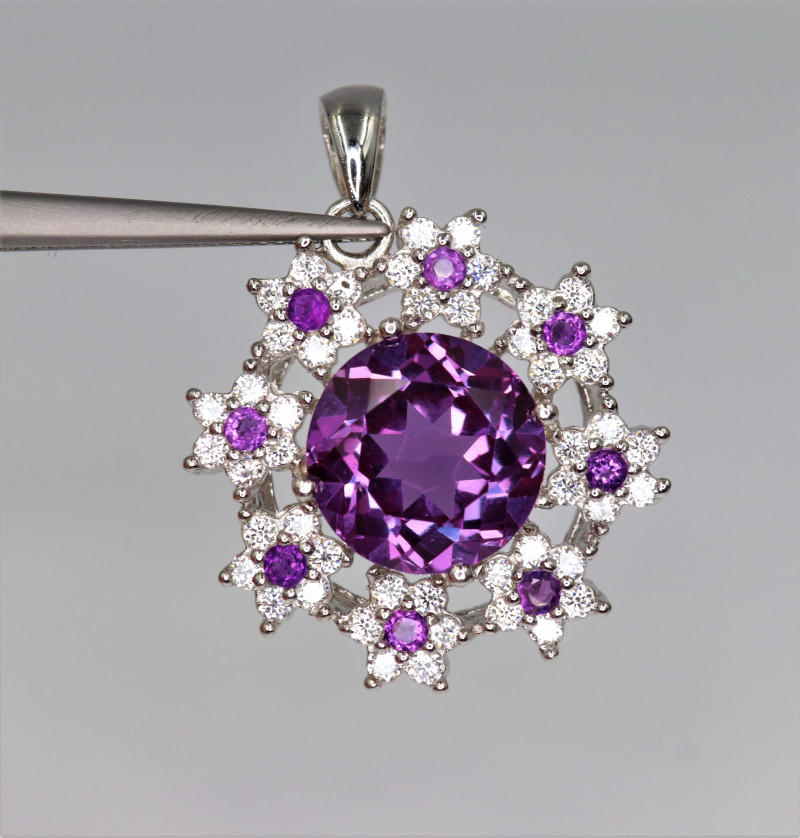
Chrysoberyl Ayaresa Nneɛma
Aboɔden abo kɔla, ahoɔden, ne sɛnkyerɛnne kwan so nneɛma ma wɔde di dwuma sɛ ahwehwɛ a ɛsa yare . Chrysoberyl a ɛyɛ ahabammono ka aboɔden abo afoforo a ɛyɛ ahabammono ho no de ahonyade, onyin, ne anigye ba. Chrysoberyl kɔkɔɔ, te sɛ ahwehwɛ kɔkɔɔ nyinaa , kanyan ahotoso kɛse, adwene a wɔde si biribi so, ne anigye.
Ahwehwɛ ayaresafo binom frɛ cymophane sɛ “Ɔbo a Ɛma Wodi Wɔn Ho So” na wɔde di dwuma de nteɛso ne anifere kɛse. Wɔ ase hɔ no, yɛbɛtwe adwene asi akwan pii mpo a wɔfa so de chrysoberyl di dwuma so!
Nipadua mu Ayaresa
Wɔ nipadua mu no, wɔkyerɛ sɛ mfaso a ɛwɔ chrysoberyl ahwehwɛ so no boa ma wonya komayare anaasɛ nkɛntɛnso bɔne biara a adwennwen nya wɔ koma no so. Wɔkyerɛ nso sɛ ahwehwɛ no ma nkwaadɔm te sɛ adrenaline kari pɛ, na ɛhyɛ koma ne mmerɛbo mu den.
Nkate mu Ayaresa
Wɔkyerɛ sɛ chrysoberyl de tema, gye a wogye tom, ne bɔne fafiri brɛ nea ɔhyɛ no, ma ɔno ankasa ne afoforo. Sɛ woresisi gyinae a ɛyɛ den nanso wote nka sɛ nkate ahyɛ wo so a, ahwehwɛ no betumi ama w’adwene ayɛ mmerɛw na aboa wo ma woahu mfaso ne ɔhaw ahorow ankasa a ɛwɔ paw biara mu.
Bio nso, chrysoberyl bo no so ba obiara a ɔrepere sɛ obegye n’adwenem naayɛ no so mfaso denam nkate a ɛma ɔte nka sɛ ɔsom bo no so. So woyɛ adebɔ ho adwuma? Saa ahwehwɛ yi betumi ama wo tumi de ahotoso abɔ ade, na ama w’adwene ayɛ kɛse bere a ɛma wo nteɛso a wode bɛkɔ so ayɛ adwuma no.
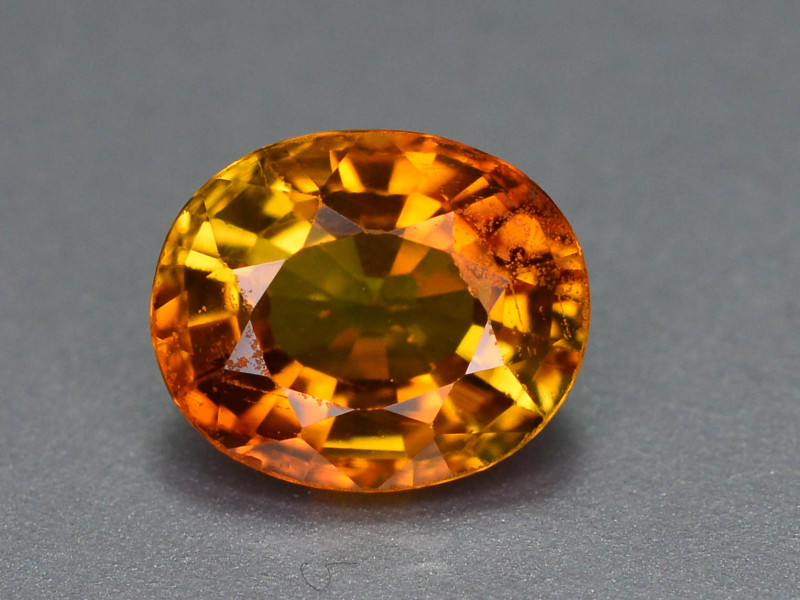
Chrysoberyl Aboɔden Aboɔ Nneɛma a Ɛwɔ Hɔ
Ɛsɛ sɛ abenfo hwehwɛ aboɔden abo pɔtee bi mu na ama wɔahu mfaso a ɛwɔ so. Chrysoberyl bo betumi ayɛ soronko wɔ ahorow biako mu, titiriw alexandrite.
Wɔ chrysoberyl dodow no ara mu no, su horow a ɛho hia a ɛsom bo ne kɔla, nea wɔatwa, nea emu da hɔ, ne carat mu duru.
Ahosuo
Chrysoberyl kɔla a ɛtaa ba ne ahabammono a ɛyɛ mmerɛw kosi kɔkɔɔ anaa kɔkɔɔ-ahabammono, a wohu wɔ chrysoberyl ne cymophane a ɛteɛ mu. Saa kɔla ahorow yi fi dade efĩ kakraa bi mu. Chrysoberyl kɔkɔɔ ne ahabammono, alexandrite, nya ne kɔla fi chromium mu, bere a vanadium ahabammono no kɔla yɛ... yiw, vanadium!
Ɔkraman aniwa kɔla a ɛsom bo sen biara ne ɛwo anaasɛ sika kɔkɔɔ-kɔla, esiane “nufusu ne ɛwo” nkɛntɛnso a wuhu bere a wodannan ɔbo no nti. Alexandritefo a wɔn kɔla sesa kɛse no hyɛ nneɛma bo a ɛkorɔn sen biara. Wɔ chrysoberyl a ɛyɛ mpapahwekwa fam no, nea eye sen biara no wɔ ahabammono anaa kɔkɔɔ a ɛyɛ ma.
Twa
Mpɛn pii no, sɛnea chrysoberyl no yɛ nea ɛda adi pefee no na ɛkyerɛ sɛnea wobetwa no. Ɛkame ayɛ sɛ bere nyinaa na nhwɛsode ahorow a ɛda adi no bɛyɛ faceted , mpɛn pii no wɔ kurukuruwa a ɛhyerɛn anaa anammɔn a wɔatwa a ɛwɔ ahinanan anaa ahinanan nsusuwii mu.
Ɛsɛ sɛ cat’s eye chrysoberyls dan cabochons na ama wɔada wɔn optics a ɛyɛ nwonwa no adi yiye. Ebia wɔn a wotwitwa aboɔden abo adan chrysoberyl a ɛnyɛ chatoyant a ɛyɛ hann a ɛyɛ hann no ayɛ no cabochons anaa nneɛma a wɔasen .
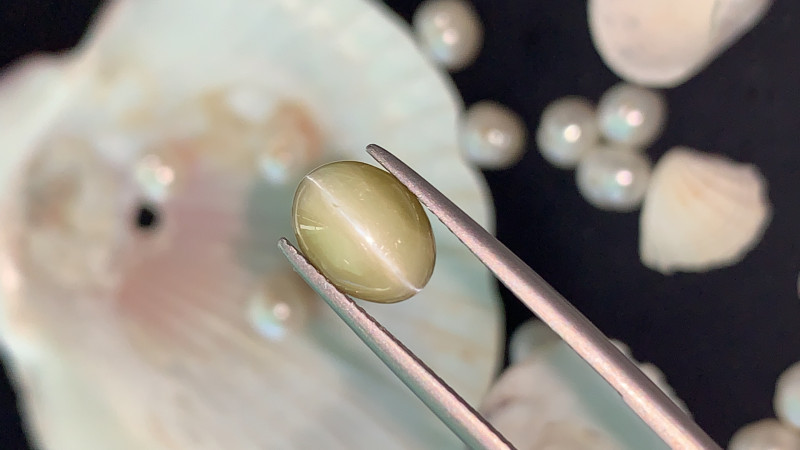
Ɛda adi pefee
Nkonimdi abasobɔde ahorow kyerɛkyerɛ sɛnea nneɛma a wɔde ka ho a wotumi hu wɔ aboɔden abo mu no mu. Chrysoberyl has a Type I colored gemstone clarity grade , a ɛkyerɛ sɛ ɛnyɛ nea wɔde ka ho anaasɛ ɛwɔ nea ɛka ho nkutoo a wotumi hu wɔ 10x kɛseyɛ ase.
Wɔ chrysoberyl dodow no ara fam no, sɛ wɔde ka ho kakraa bi a, ɛkyerɛ sɛ ɛsom bo kɛse. Nea ɛka ho nkutoo ne cymophane aboɔden abo a ɛde ne ho to rutile nketenkete a ɛne ne ho di nsɛ so ma wɔn “ɔkraman aniwa” nkɛntɛnso soronko no. Nneɛma afoforo a wɔtaa de ka chrysoberyl ho ne goethite ne actinolite.
Carat Mu duru
Wɔtaa hu cymophane a ɛyɛ aboɔden abo ne chrysoberyl a ɛnyɛ den, a wɔannoa no, wɔ nhwɛsode ahorow a emu duru yɛ carat ɔhaha pii mu. Nanso, faceted chrysoberyls taa yɛ nea ennu 40-50 cts — biribiara a ɛboro eyi so no ho yɛ na na wɔhwehwɛ.
Ayaresa & Nneɛma a Wɔde Yɛ Nneɛma
Wɔnnyɛ chrysoberyl dodow no ara ho adwuma, gye sɛ wɔde kɔla, mframa a ano yɛ den , anaa ngo a wɔntaa nyɛ wɔ cymophane so na ama ne kɔla atu mpɔn.
Nyansahufo nam akwan kakraa bi so yɛ chrysoberyl a wɔayɛ . Ɔkwan biako a wɔfa so yɛ ɔkraman aniwa mu aboɔden abo ne flux nyin, baabi a wobɛbɔ flux de apete nneɛma mu ayɛ no aduru a ɛyɛ nwini na ɛde nkakrankakra yɛ ahwehwɛ.
Ade foforo a wɔtaa yɛ ne nsu mu hyew a enyin. Eyi hwehwɛ sɛ wɔma tebea horow a ɛma abɔde mu nneɛma (ɔhyew ne nhyɛso dodow) no yɛ ahwehwɛ no.
Wɔ saa nkyerɛwde no so no, ɔkwan bɛn so na abɔde mu chrysoberyl yɛ?

Chrysoberyl Nneɛma a Wɔyɛ & Nea Efi Hɔ
Chrysoberyl yɛ granite, granite pegmatites, anaa abotan a ɛsakra a beryllium wom mu. Ahwehwɛ no fii ase mfe ɔpepem pii a atwam ni wɔ Asase no atifi.
Ɔhyew a ɛyɛ hyew ne nhyɛso kɛse a ɛwɔ akyi mantle no mu no piaa magma a ɛyɛ hyew kɔɔ soro bɛn Asase ani. Magma no mu dodow no ara yɛɛ nwini nkakrankakra, na ɛmaa nsu a kan no atrɛw no boaboaa ano wɔ magma no afã horow a ɛyɛ nsu a aka no mu.
Bere a nsu no kɔɔ fam no, ɛfaa nneɛma afoforo ne aboɔden abo ma ɛyɛɛ ano aduru, titiriw no, ɛfaa beryllium fi magma a ayow ne abotan a ɛbɛn hɔ no mu. Bere a nsu no yɛɛ nwini no, nneɛma ne aboɔden abo no yɛɛ ahwehwɛ bɛyɛɛ chrysoberyl.
Magma ne abotan a beryllium wom no yɛ nea ɛwɔ mmeae bi nkutoo. Enti, ɛhe na wohu chrysoberyl?
Mmeae a Wɔtu Tuo
Chrysoberyl ahorow bi fi beae biako pɛ, te sɛ Tanzania vanadium ne Burma chrysoberyl a wɔntaa nhu a enni kɔla. Saa ara nso na alexandrite dodow no ara fi Russia.
Sri Lanka ne Brazil ne aman titiriw a wɔyɛ chrysoberyl a ɛnyɛ den, nanso nneɛma afoforo a wonya fi mu ne:
Australia
Austria
Bulgaria na ɛwɔ hɔ
China
Czechia na ɛwɔ hɔ
India
Madagascar
Myanmar na ɛwɔ hɔ
Pakistan
U.S.A. (Maine ne New Mexico) .
Zimbabwe na ɛwɔ hɔ
Nokwarem no, bo yɛ ade titiriw a ɛma wɔtɔ nneɛma. Chrysoberyl bo yɛ ahe?
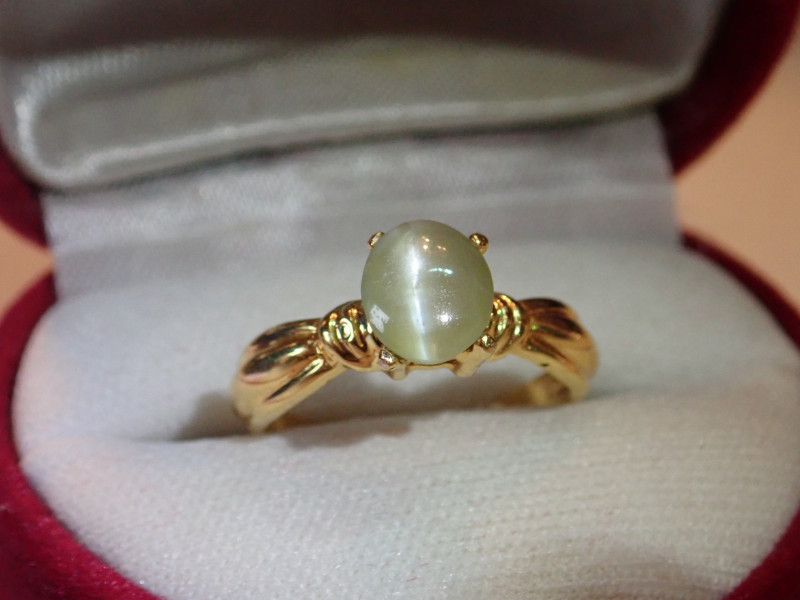
Chrysoberyl Bo & Ne Bo
Wɔ aboɔden abo a ɛwɔ afã horow ho no, chrysoberyl bo a ɛwɔ carat biara mu nyinaa fi dɔla 20 wɔ carat biara mu kosi bɛboro dɔla 2,000 wɔ carat biara mu. Dɛn nti na chrysoberyl bo yɛ den saa? Bo no gyina ahorow ahorow no so, ne nea ɛho yɛ na no.
Sɛ́ nea ɛho yɛ na sen biara no, alexandrite nya dɔla 500-100,000 wɔ carat biara mu. Vanadium a ɛno nso ho yɛ na no taa yɛ bɛyɛ dɔla 1,000 wɔ carat biara mu.
Esiane sɛ ɛnyɛ chrysoberyl nyinaa na ɛda “ɔkraman aniwa” adi nti, nea ɛte saa no bo yɛ den.
Chrysoberyl cat’s eye cabochons fi $150-$1,000 wɔ carat biara mu ma abo kɔkɔɔ-ahabammono. Wɔn a wɔn kɔla yɛ bruu no bo yɛ dɔla 60-900 wɔ carat biara ho, bere a nea wɔde ɛwo kɔla ayɛ no betumi adu dɔla 2,000 wɔ carat biara mu.
Chrysoberyl aboɔden abo a wɔtaa de di dwuma no bo yɛ $60-$500 wɔ carat biara mu ma abo kɔkɔɔ. Chrysoberyls a ɛyɛ ahabammono kɔ $40-$800 wɔ carat biara mu. Aboɔden abo a ɛyɛ kɔkɔɔ-akutu anaa ɛwo kɔkɔɔ a wɔahyɛ no ma no bo yɛ den kɛse wɔ $700-$1,000 wɔ carat biara mu. Sri Lanka chrysoberyl ahorow bi a ɛyɛ kɔkɔɔ te sɛ lemon tumi gye bɛboro dɔla 2,000 wɔ carat biara mu.
Ɔkwan a ne bo yɛ den sen biara ne chrysoberyl rough a ne bo yɛ $40-$60 wɔ carat biara mu.
Sɛ yɛhwɛ ne bo a, wobɛpɛ sɛ wohwɛ hu sɛ wo chrysoberyl no bɛkɔ so ayɛ nea ɛwɔ soro bere tenten biara a wubetumi!
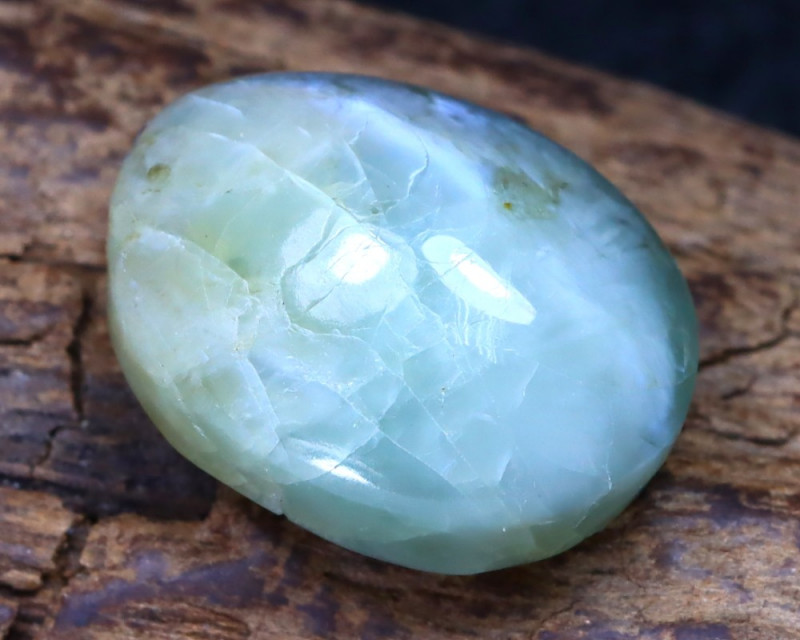
Chrysoberyl Hwɛ ne Nsiesiei
Sɛnea ɔbo no yɛ den a ɛyɛ nwonwa no ma ɛyɛ mmerɛw sɛ wɔbɛhwɛ aboɔden abo a wɔde hwɛ chrysoberyl so.
Ɔkwan a ahobammɔ wom sen biara a wobɛfa so ahohoro chrysoberyl ho ne sɛ wode nsu a ɛyɛ hyew a samina wom ne brɔs a ɛyɛ mmerɛw bedi dwuma. Nanso, chrysoberyl dodow no ara yɛ nea asiane biara nni ho sɛ ɛbɛkɔ wɔ steam anaa ultrasonic cleaners mu. Kae kɛkɛ sɛ wobɛhohoro nea aka biara afi ɔbo no so akyi.
Ma wo chrysoberyl agude no ntwe mfi ɔhyew a ano yɛ den ne ofie nnuru te sɛ bleach ho. Ɛyɛ papa sɛ wode besie wɔ baabi a ɛda nsow wɔ aboɔden abo afoforo ho.

Chrysoberyl: Ntwitwiridii a Ɛyɛ Nkyeremu a Ɛboro Nkae no So!
Chrysoberyl yɛ ɔbo a egu ahorow, na ne ahorow biara da nsow. Cymophane ne ɔkraman aniwa aboɔden abo a wonim no yiye, bere a alexandrite da kɔla nsakrae a emu yɛ den sen ɔbo biara adi.
Wubetumi de chrysoberyl mpɛtea ayɛ wo hokafo nwonwa ama w’afahyɛ, de bi asɔ w’adwene, anaasɛ wobɛhyɛ kɛkɛ esiane n’ahoɔfɛ nti. Sɛnea wode chrysoberyl bedi dwuma biara no, akyinnye biara nni ho sɛ ɛbɛkyere wo!
搜尋Gemstone Encyclopedia
相關拍賣
相關文章
Momma yɛnkyerɛkyerɛ sɛnea wɔtɔ aboɔden abo wɔ intanɛt so. Yɛwɔ aboɔden aboɔ a ɛso sen biara wɔ intanɛt so na ɛbɛtumi ayɛ den kakra wɔ mfitiaseɛ no. Ma yɛmfa afotu bi a mfaso wɔ so mmoa wo.
3rd Oct 2018
W’aboɔden abo a wobɛhwɛ so no boa ma ɛyɛ fɛ wɔ wo nkwa nna nyinaa mu. Yɛbɛka nneɛma te sɛ denden ne ayaresa ho asɛm, ne anammɔn a ɛfa sɛnea wobɛhohoro wo aboɔden abo na wode asie dwoodwoo ho.
9th May 2018
So woasusuw sɛnea wɔyɛ Ruby aboɔden abo ho pɛn? Ayaresa ahorow pii wɔ gua so na yɛbɛboa ma yɛakyerɛkyerɛ mu
9th May 2018
最新的文章
Nnua a wɔde asonse a wɔasen a wɔsan frɛ no nhabannuru asonse no yɛ abɔde mu ade a wɔde si asono asonse ananmu, na wotwa fi Amerika Kesee Fam phytelephas nnuadewa mu nnuadewa mu wɔ abrabɔ pa mu. Sua mmɛw asonse ho ade nyinaa wɔ akwankyerɛ yi mu!
15th Jan 2026
Chrysanthemum nhwiren abo yɛ abɔde mu anwonwade a ɛwɔ calcite, celestite, anaa andalusite nhwiren fitaa bi a wɔde asisi limestone tuntum anaa atɛkyɛ abo so.
13th Jan 2026
Rainbow lattice sunstone yɛ feldspar ahorow a ɛwɔ optical nsunsuanso abiɛsa fɛfɛ a efi nneɛma ahorow a wɔde ka ho a ɛwɔ hɔ no mu ba. Ɛyɛ ogya kɔla display ne lattice nsusuwso ma ɛyɛ coletor abohene a wɔntaa nhu!
12th Jan 2026
文章類別
How To's is where you will find helpful articles from gem Rock Auctions on how to cut gemstones, select gemstones and buy gemstones.
9文章





